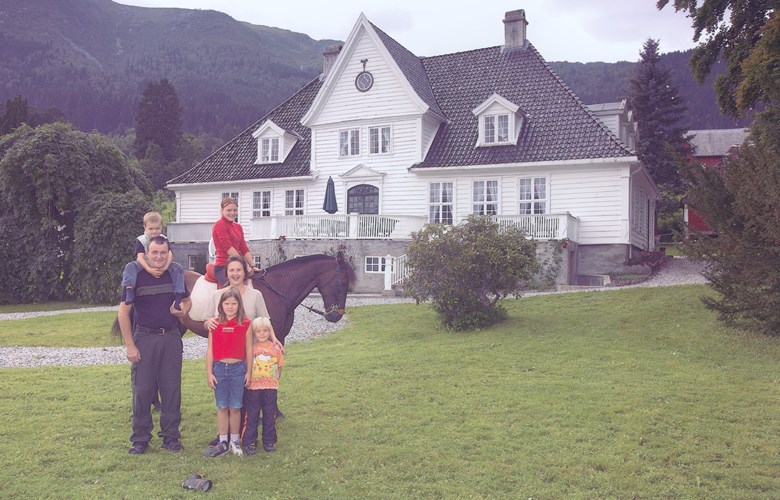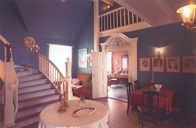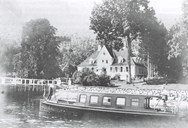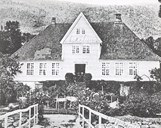Askelund becomes the bailiff's residence
Originally Askelund was part of the neighbouring farm Fjærestad. In 1790 the Bailiff Jacob Hegelund from Denmark bought the estate. This beautiful place had come to his attention and he started an extensive development of the property. He built a large main building and a smaller one called the school house. Hegelund also constructed outbuildings, a storehouse on pillars, "eldhus" (house used for baking, brewing, cooking and laundering) with a built-in large pan, a servants' hall, and houses for the animals. He planted an orchard and a vegetable garden. At this time the fjord was the traffic artery and people who came to see the bailiff came by boat, either rowing or sailing. Hegelund therefore built a 160 feet long pier below the main building. In the 10 next years Hegelund changed the property from being a croft under Fjærestad to a large and grand estate. Askelund became a centre by the Sognefjord.
Johan Nordal Brun at Askelund
Bishop Johan Nordal Brun visited Askelund 20 July 1806. Brun wrote about his journey: " At Askelund everything is brilliant, not to speak of the food and dishes, and the dancing in the evenings." At the party there were many types of wine and champagne. Brun continues: "The peasants were treated to beer and spirits in order to get them to dance." When he gave his speech, Bishop Brun stood by the beautiful weeping birch and talked to the people. He was an authoritative bishop and a great hymn writer. At this festivity canons were fired in honour of the guests. The host, Bailiff Holck, had invited a dean, two magistrates, two infantry captains and most of the officials in Sogn.
New bailiffs
In 1814 Askelund was bought by Bailiff Rasmus Endresen. Endresen however, messed up things. He was involved in many lawsuits with his neighbours, some were of a private nature, others concerning his official duties. Also, he did not manage the financial side of his office. In due time his supeiors had to intervene. In the end he was dismissed as bailiff because a lot of money was missing. Endresen died in 1841 and his widow kept the property until 1846 when the deed went to Johan Winding Landmark, who became an important man in the local community.
"I vote for the Bailiff"
When Balestrand got its local government in 1849 the first elections were held in the garden at Askelund. The farmers met outside the window of the bailiff's office. When he election started Landmark opened the window and informed about the new electoral system. Then he told them how he would vote. The bailiff called out the names of the farmers after the register of taxpayers like it was done when the tax was paid. "Who do you vote for?" asked the bailiff. "I vote for the bailiff", many of them answered. By the office window two clerks were recording the votes. The bailiff did not like that the farmers had different opinions than him about the election. One of the first to disagree with him was Eirik Fjærestad. "Trust you to disagree, Eirik" the bailiff grumbled annoyed.
Renovating farming
One of the first things that Landmark took care of was the mountain farm Langestølen, lot no 11. In 1847 he fronted the effort to increase the production in this valley. He made arrangements with the farmers of Fjærestad, Sjøtun and Bale how to use the pastures. Landmark was later called The Old Bailiff, and no bailiff ever had the same position with the farmers as he had. He was spokesman for better farming and advised the farmers to plant forest on their land. Landmark owned a field that the farmers regarded with wonder. There he sowed 1/4 bushel of winter oats and harvested 0.7 barrel. He sowed 1 bushel winter rye and harvested 2 barrels, 1 barrel barley and harvested 5 barrels, 0.5 barrel of mixed grain and got 5 barrels, 0.5 barrels of oats and harvested 5 barrels, 1/4 bushel of peas and harvested 1 bushel. He also planted and 6 barrels of potatoes and got a crop of 50 barrels. In addition he also used to harvest 2-3 barrels of swede. The bailiff got larger crops than the farmers.
The bailiff's dog
Landmark had a big dog which at times could be a nuisance to people. The road passed through the bailiff's yard, and the dog was often loose. It often ripped people's clothes, but they were afraid to complain because it was the bailiff's dog. The students at the teachers college complained to their headmaster, Brun who told the bailiff. However, it was of no avail. In the end a couple of students killed the dog. On a dark autumn night they entered the bailiff's yard with a loaded gun. The dog came, but it did not bark. As they put the barrel into its mouth the dog bit into it. The dog did not let go and they were able to drag it with them away from the house. When they felt safe they shot the dog in the throat. The body was sunk in the fjord and was never seen again. Landmark promised 5 spd to anyone who could give information about the dog, but no one came forward. Johan Landmark acted as bailiff until he died in 1878. In 1898 the bailiff's office was closed down and the state prepared to sell Askelund
The bailiff and the villagers
The relationship between the bailiff and the villagers was not always easy. Landmark had a strong position with the farmers, but often things happened that people did not like. Anton Thue was sent to the bailiff to pay taxes. The bailiff refused to take the money from "minor hands" and chased Anton away. His father had to come himself. Those who lived at Askelund could often help people when they were sick. The people here had knowledge of remedies that ordinary people knew nothing about. The old road went through the yard. The old servants' hall was situated above the road next to the storehouse. This was the regular meeting place for the youngsters in the village. When there was a party at Askelund the government officials often asked the young villagers to come and dance. Girls with aspirations wanted to work at Askelund, but many of the bailiff wives were strict with the servants. Washing the clothes was very hard work, especially in winter time.The washing was done in the bailiff-brook. One mistress demanded that not one drop of water should touch the floor in the attic where the washed clothes were hung to dry. The girls had to wring the clothes long and well to get rid of the cold water. Those who had to do this were often unable to feel their hands for a long time afterwards.
Bonnevie Angell
Hans Bonnevie Angell became Managing Director of Bergen Sparebank. He was the brother of Colonel Angell who often visited Balestrand. Hans Angell died in 1909. Hans and Natalie's initials are found several places in the house, on furniture and over the main entrance. The widow Nathalie took over Askelund and gradually got rid of most of it.
German owners
The German Emperor had made Balestrand famous in Germany. When the war came, the new hotel's basis disappeared. In the autumn of 1913, Frantz Reinboth was on a business trip in the USA. He gave Gressen in Germany as his place of birth and 1888 as the year of birth. In 1916 Christine Reinboth sold Askelund to the General Managers Josef Emanuel Danielsen and Paul Scholz for 55 000 kroner. Danielsen was a bachelor and General Manager of United Sardin Factory at Nordnes. He lived in a large villa at Fjøsanger with two sisters. Paul Scholz was German and founded Bergen Blikktrykkeri. His wife, whose name was Gunda, came from Stavanger. Paul and Gunda had 10 children and the whole family used Askelund as their summer residence.
Wealthy people from Bergen
Danielsen og Scholz stayed here every summer until the middle of September. They had little contact with Mrs Adelsteen Normann and other villa residents. They had no contact with the rest of the local society.
The Sogn home mission starts a school
In the 1930s Sogn Indremisjon was looking for a suitable place to start a county college. They got in touch with Mr. Danielsen and in 1936 they bought his property for 44 000 kroner. Gradually school facilities like lodgings, a building for woodworks and a gymnasium were built. For many years the school at Askelund held an important position in Balestrand and the rest of Sogn. In the 1980s the school had difficulties recruiting new students. During the last part of the 1980s the buildings were used to accommodate refugees. In the late 1980s the beautiful main building was renovated and restored to its original period character. It has been used for different cultural events like art exhibitions and concerts.
New life in Futegarden
There are many, large houses at Askelund. The property is 5500 m2 floorage distributed on the bailiff's house, the school building with a gym, apartments and hall of residence. Some of it is let. The family lives in what used to be the workshop when Askelund was a school. The bailiff's house is used for entertaining and overnight accommodations only.





